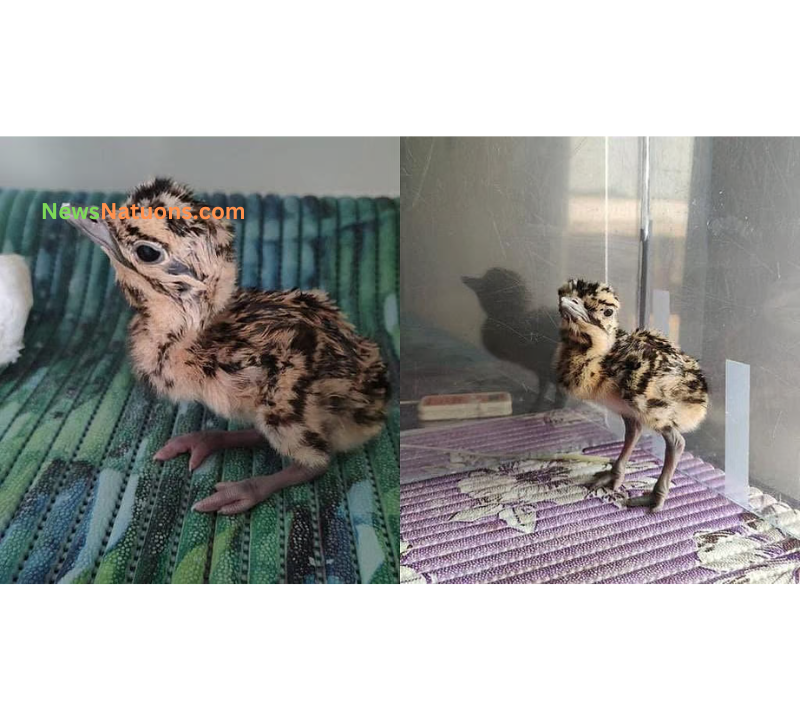In a groundbreaking achievement for wildlife conservation, India has become the first country to successfully breed an endangered bird species using artificial intelligence (AI) technology. This historic milestone involves the Great Indian Bustard (GODAWAN), one of the world’s most critically endangered birds.
The successful hatching marks a major leap in AI-driven conservation efforts, offering new hope for saving species on the brink of extinction. This article explores how AI made this possible, the science behind it, and what it means for global wildlife preservation.
The Great Indian Bustard: A Bird on the Brink
The Great Indian Bustard (Ardeotis nigriceps), locally known as Godawan, is a majestic bird native to the Thar Desert in Rajasthan.
Why Is It Endangered?
- Habitat Loss: Expanding agriculture and infrastructure.
- Hunting & Poaching: Illegal activities threaten survival.
- Low Reproduction Rate: Only 150-200 individuals remain in the wild.
With extinction looming, scientists turned to AI-assisted breeding as a last resort.
How AI Helped Breed the First Bustard Chick
The breakthrough took place at the Conservation Breeding Centre in Rajasthan, where researchers used AI to monitor and optimize breeding conditions.
Key Steps in AI-Assisted Breeding:
- AI-Based Monitoring
- Sensors tracked breeding behaviors, egg health, and environmental factors.
- Machine learning algorithms predicted optimal hatching conditions.
- Artificial Insemination (March 16, 2024)
- AI helped determine the best time for insemination.
- A female bustard named “Tony” successfully laid a fertilized egg.
- Successful Hatching
- The chick hatched six months after AI implementation.
- This was the 8th chick born this season, increasing the captive population to 52.
Why Is This a Global Milestone?
India’s success could revolutionize endangered species conservation worldwide.
1. First-Ever AI-Assisted Bird Birth
- No other country has used AI to breed a critically endangered bird before.
2. Replicable Model for Other Species
- The same technique was tested on Houbara bustards in Abu Dhabi (IFHC) before being adapted in India.
3. Hope for Other Endangered Birds
- Species like the Bengal Florican & Siberian Crane could benefit next.
The Science Behind AI in Wildlife Conservation
AI is transforming conservation in multiple ways:
1. Predictive Analytics
- AI forecasts breeding cycles and health risks.
2. Behavioral Analysis
- Tracks mating habits and stress factors.
3. Climate & Habitat Optimization
- Adjusts temperature and humidity for ideal hatching.
Challenges & Future Steps
While this is a major win, challenges remain:
1. Genetic Diversity Concerns
- Small captive populations risk inbreeding.
2. Reintroduction to the Wild
- Will AI-bred bustards survive in natural habitats?
3. Scaling the Technology
- Can AI be used for mammals, reptiles, and marine life?
Conclusion: A New Era for Conservation?
India’s AI-assisted bustard breeding program proves that technology can help save species from extinction. If expanded, this approach could rewrite the future of global wildlife conservation.
What’s Next?
- More AI trials for other endangered species.
- International collaborations for conservation tech.
- Public awareness to support such initiatives.
عظیم ہندوستانی بسٹرڈ، جسے مقامی طور پر گوداون کہا جاتا ہے، اپنی بقا کے شدید خطرے سے دوچار ہے۔ اس کی سب سے بڑی وجہ انسانی سرگرمیوں کی وجہ سے اس کے قدرتی مسکن کا تیزی سے خاتمہ ہے۔ زراعت میں توسیع اور انفراسٹرکچر کے بڑھتے ہوئے منصوبوں نے اس پرندے کی رہائش گاہوں کو شدید متاثر کیا ہے۔ غیر قانونی شکار اور چرائی کی بڑھتی ہوئی شرح نے بھی اس کے وجود کو خطرے میں ڈال دیا ہے۔ اس کے علاوہ، اس پرندے کی قدرتی طور پر کم افزائشی صلاحیت بھی اس کے معدوم ہونے کے خطرے کو بڑھا رہی ہے۔ فی الحال صرف 150 سے 200 کے قریب پرندے ہی جنگلی حالت میں باقی بچے ہیں، جو اس کی نازک صورتحال کو ظاہر کرتا ہے۔
مصنوعی ذہانت کی مدد سے افزائش کا طریقہ کار
راجستھان کے کنزرویشن بریڈنگ سینٹر میں سائنسدانوں نے مصنوعی ذہانت کے جدید ترین ٹیکنالوجی کا استعمال کرتے ہوئے اس نایاب پرندے کی افزائش میں کامیابی حاصل کی۔ اس عمل میں سب سے پہلے خصوصی سینسرز کے ذریعے پرندوں کے افزائشی رویوں، انڈوں کی صحت اور ماحولیاتی عوامل کی مسلسل نگرانی کی گئی۔ مشین لرننگ الگورتھمز نے ان تمام ڈیٹا کا تجزیہ کر کے بہترین ہچنگ کے حالات کا تعین کیا۔ 16 مارچ 2024 کو مصنوعی تناسل کا عمل انجام دیا گیا، جس میں AI ٹیکنالوجی نے تناسل کے لیے موزوں ترین وقت کا صحیح تعین کیا۔ ٹونی نامی مادہ پرندے نے کامیابی سے فرٹیلائزڈ انڈا دیا، جو چھ ماہ بعد ایک صحت مند چوزے کی شکل میں نکلا۔
اس کامیابی کی عالمی اہمیت و اثرات

بھارت کی یہ کامیابی نہ صرف ملک بلکہ پوری دنیا میں جنگلی حیات کے تحفظ کے لیے ایک سنگ میل کی حیثیت رکھتی ہے۔ یہ پہلا موقع ہے جب کسی ملک نے مصنوعی ذہانت کی مدد سے کسی خطرے سے دوچار پرندے کی کامیاب افزائش کی ہو۔ اس سے قبل ابوظبی میں ہوبارا بسٹرڈز پر اسی طرح کا تجربہ کیا گیا تھا، جس کی کامیابی نے بھارتی سائنسدانوں کو حوصلہ دیا تھا۔ اس کامیابی سے نہ صرف گوداون بلکہ بنگال فلوریکن اور سائبیرین کریں جیسی دیگر خطرے سے دوچار پرجاتیوں کے تحفظ کی نئی راہیں کھلی ہیں۔ یہ ٹیکنالوجی مستقبل میں دیگر جنگلی حیات کے تحفظ کے لیے بھی اہم ثابت ہو سکتی ہے۔
مستقبل کے چیلنجز اور امکانات
اگرچہ یہ کامیابی اہم ہے، لیکن ابھی کئی چیلنجز درپیش ہیں۔ سب سے بڑا چیلنج قید میں پرندوں کے چھوٹے گروپ میں جینیاتی تنوع کو برقرار رکھنا ہے، جس کے بغیر آبادی کی صحت کو طویل المدت میں خطرہ لاحق ہو سکتا ہے۔ دوسرا اہم مسئلہ یہ ہے کہ آیا یہ مصنوعی ذہانت سے پیدا ہونے والے پرندے جنگلی ماحول میں زندہ رہ پائیں گے۔ تیسرا بڑا چیلنج اس ٹیکنالوجی کو دیگر انواع تک وسعت دینا ہے، خاص طور پر دودھ پلانے والے جانوروں، رینگنے والوں اور آبی حیات کے لیے۔ ان تمام چیلنجز کے باوجود، یہ کامیابی جنگلی حیات کے تحفظ کے نئے دور کا پیش خیمہ ثابت ہو سکتی ہے۔











